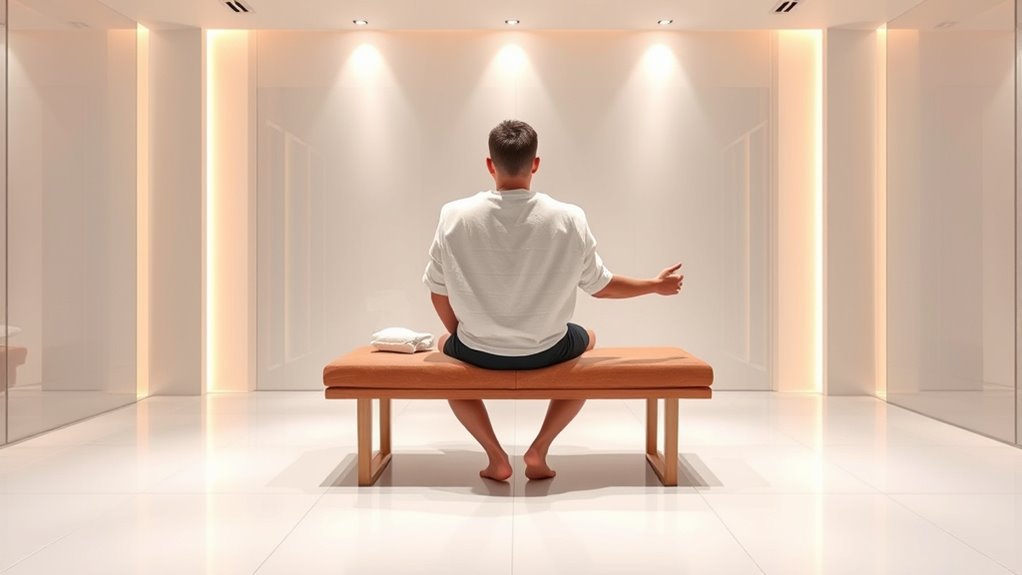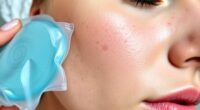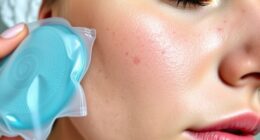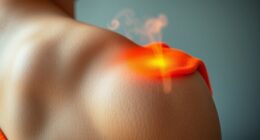Contrast therapy involves switching between hot and cold treatments to boost circulation and reduce inflammation. You start with a few minutes of heat to relax muscles and increase blood flow, then switch to cold to constrict blood vessels and limit swelling. Repeating this cycle helps flush out inflammatory substances and speeds recovery. If you’re interested, you’ll discover more about how ideal timing and technique can maximize your healing benefits.
Key Takeaways
- Alternating hot and cold therapy improves circulation, reduces inflammation, and accelerates muscle recovery.
- Heat relaxes muscles and eases stiffness, while cold minimizes swelling and numbs pain.
- Typical routine involves 3-5 minutes of heat followed by 1-2 minutes of cold, repeated 3-4 times.
- Cycles promote vasodilation and vasoconstriction, enhancing the body’s natural healing process.
- Proper application and listening to body signals optimize recovery and prevent discomfort.
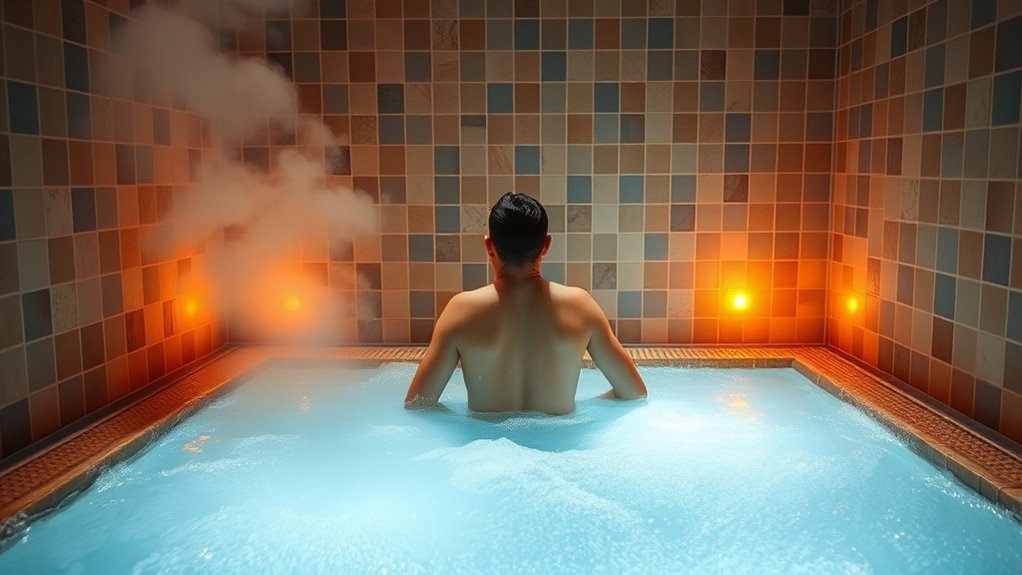
Have you ever wondered how alternating between hot and cold treatments can boost your recovery and reduce muscle soreness? It’s a technique called contrast therapy, and it’s gaining popularity among athletes and fitness enthusiasts alike. When you switch between heat and cold, you’re actively influencing your body’s blood flow and inflammation levels, which are key factors in recovery.
When you apply heat, your blood vessels expand, increasing blood flow to your muscles. This surge of fresh blood delivers oxygen and nutrients, helping to repair tissue damage and remove metabolic waste. The warmth also relaxes your muscles, easing stiffness and reducing the sensation of pain. Conversely, when you switch to cold, your blood vessels constrict, which helps limit inflammation and swelling. Cold therapy reduces blood flow temporarily, slowing down nerve signals that transmit pain and decreasing tissue inflammation. This cycle of vasodilation and vasoconstriction promotes a more efficient healing process.
By alternating hot and cold, you’re fundamentally creating a pump effect that enhances circulation. This process flushes out inflammatory substances and brings in fresh blood that accelerates recovery. The increased blood flow from heat helps break up congestion in muscles, while cold constriction reduces swelling and inflammation. Repeating this cycle encourages your body to heal faster, making soreness less intense and recovery quicker.
Alternating hot and cold boosts circulation, reduces soreness, and accelerates recovery.
In addition to physical benefits, contrast therapy can also improve your overall comfort. The hot treatment relaxes tight muscles, making it easier for you to stretch or move without discomfort. The cold, on the other hand, numbs pain and reduces inflammation, giving you relief from soreness and swelling. This combo can be especially effective after intense workouts or injuries, where inflammation and muscle tightness are common issues. Moreover, using an air purifier in your recovery space can help maintain clean air, reducing allergens and irritants that might hinder healing.
To incorporate contrast therapy into your routine, start with a warm soak or hot pack on the affected area for about 3-5 minutes. Follow that with a cold pack or ice application for 1-2 minutes. Repeat the cycle 3-4 times, ending with cold if you want to minimize inflammation. Always listen to your body—if cold feels too intense or uncomfortable, adjust the duration accordingly. Remember, the key is to create a balance that boosts blood flow while controlling inflammation, helping your muscles recover faster and feel better sooner.
Frequently Asked Questions
Can Contrast Therapy Be Used for Chronic Pain Management?
Yes, contrast therapy can be an effective alternative pain management method for chronic pain. By alternating hot and cold, you stimulate circulation and reduce inflammation, which may help alleviate discomfort over time. The therapy benefits include improved mobility and decreased muscle tension. You should always consult with a healthcare professional before starting contrast therapy to guarantee it’s suitable for your specific condition and to maximize its effectiveness.
How Long Should Each Hot and Cold Session Last?
Time is of the essence, so don’t overdo it. For contrast therapy, keep each hot and cold session around 10 to 15 minutes, following duration guidelines for safe and effective results. It’s best to alternate hot and cold every 1 to 3 minutes, depending on your comfort level. Pay attention to how your body responds, and adjust session timing accordingly to avoid overstimulation or discomfort.
Are There Any Safety Risks Associated With Contrast Therapy?
Yes, contrast therapy can pose safety risks if you’re not careful. You should pay attention to temperature regulation to avoid burns or frostbite, especially if you have skin sensitivity or circulation issues. Always test the temperature beforehand and limit exposure time. If you experience pain, dizziness, or numbness, stop immediately. Consulting a healthcare professional is recommended to guarantee contrast therapy is safe for your specific health condition.
Is Contrast Therapy Suitable for All Injury Types?
Contrast therapy isn’t suitable for all injury types. You should avoid it if you have open wounds, infections, or acute injuries, as it could worsen inflammation or cause further damage. For chronic injuries or muscle soreness, it can be beneficial, but always consider therapy suitability based on your specific injury. Consult a healthcare professional before trying contrast therapy to guarantee it’s appropriate and safe for your condition.
How Frequently Should Contrast Therapy Be Performed for Optimal Results?
You should perform contrast therapy 2-3 times a week for the best results. Stick to a consistent session frequency, ideally spacing sessions every 48 hours to allow your body to recover and respond effectively. The ideal timing depends on your injury or soreness level, but usually, a 15-20 minute session works well. Overdoing it may hinder recovery, so listen to your body’s signals and adjust accordingly.
Conclusion
So, next time you’re aching after a workout, just switch between hot and cold—because what’s more fun than playing human ping-pong with your body? Sure, some say it speeds recovery, but really, it’s just an excuse to indulge in a personal sauna and ice bath combo. Who knew recovery could double as a bizarre spa ritual? Embrace the chaos—your muscles will thank you, or at least, they’ll be too confused to protest.
